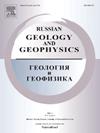西伯利亚克拉通西南架早泥盆世岩柱-岩石圈相互作用的地质和同位素地球化学标志:阿尔泰-萨扬裂谷系岩浆组合资料综合
IF 1
4区 地球科学
Q3 GEOSCIENCES, MULTIDISCIPLINARY
引用次数: 0
摘要
摘要—早泥盆世阿尔泰-萨扬裂谷系统(ASRS)已扩展至东西萨扬构造、库兹涅茨克阿拉陶构造和蒙古阿勒泰构造。它最大的碎片是图瓦盆地、德伦-尤斯蒂德盆地、坎盆地、阿古尔盆地和米努萨盆地以及蒙古西北部的洼地。本文总结了以中碱性和碱性玄武岩推覆体及其次火山岩和侵入岩类似物为代表的ASRS基性岩的地质、地球化学和Sr-Nd同位素特征。它们存在于所有岩浆组合中,分为低钛亚群(TiO2 = 0.2-2.2 wt.%)和高钛亚群(TiO2 = 2.2-4.3 wt.%)。这些岩石的Sr同位素特征变化较大(εSr(T) = -16 ~ +30)。高钛基性岩石在ASRS南段较为常见;Ta-Nb呈弱正异常(La/Nb = 0.8 ~ 1.1),相对富集LREE (La/Yb)N = 6 ~ 14)和放射性成因Nd(εNd(T) = 3.8 ~ 8.7)。低钛品种局限于ASRS的西北段;富Ba,贫Th、U、Nb、Ta (La/Nb = 1.2 ~ 2.2),贫Zr、Hf、LREE (La/Yb)N = 3 ~ 7),贫Nd(εNd(T) = 2.0 ~ 6.0)。考虑到阿尔泰—萨扬褶皱区在吸积期(约500 ~ 480 Ma)构造中存在的不同地体组合,提出了一个反映ASRS南段和西北段不同岩浆形成环境以及岩浆活动与地幔柱之间关系的模型。在成分上,羽流对应于高钛岩浆的来源。不同组地体下不同组成的熔融岩石圈地幔的作用导致ASRS内基性岩石的同位素地球化学非均质性,特别是Minusa盆地缺乏高钛基性岩石。本文章由计算机程序翻译,如有差异,请以英文原文为准。
Geological and Isotope-Geochemical Indicators of Early Devonian Plume–Lithosphere Interactions in the Southwestern Framing of the Siberian Craton: Data Synthesis for Magmatic Associations of the Altai–Sayan Rift System
Abstract ––The Early Devonian Altai–Sayan rift system (ASRS) has spread to the structures of East and West Sayan, Kuznetsk Alatau, and Mongolian Altay. Its largest fragments are the Tuva, Delyun–Yustyd, Kan, Agul, and Minusa basins as well as depressions in north-western Mongolia. The paper summarizes the geologic, geochemical, and Sr–Nd isotope characteristics of the ASRS mafic rocks represented by nappes of moderately alkaline and alkali basalts and their subvolcanic and intrusive rock analogues. They are present in all magmatic associations and are divided into low-Ti (TiO2 = 0.2–2.2 wt.%) and high-Ti (TiO2 = 2.2–4.3 wt.%) subgroups. These rocks are characterized by wide variations in Sr isotope characteristics (εSr(T) = –16 to +30). High-Ti mafic rocks are common at the southern segment of the ASRS; they show a weak positive Ta–Nb anomaly (La/Nb = 0.8–1.1) and are relatively enriched in LREE ((La/Yb)N = 6–14) and radiogenic Nd (εNd(T) = 3.8–8.7). Low-Ti varieties are confined to the northwestern segment of the ASRS; they are enriched in Ba but depleted in Th, U, Nb, Ta (La/Nb = 1.2–2.2), Zr, Hf, LREE ((La/Yb)N = 3–7), and radiogenic Nd (εNd(T) = 2.0–6.0). Taking into account the existence of different terranes, which were combined in the structure of the Altai–Sayan folded area during accretion (ca. 500–480 Ma), we propose a model suggesting different environments of magma formation at the southern and northwestern segments of the ASRS and the relationship of magmatism with a mantle plume within the ASRS. In composition the plume corresponds to the sources of high-Ti magmas. The effect of the melted lithospheric mantle of different compositions beneath different groups of terranes led to the observed isotope-geochemical heterogeneity of mafic rocks within the ASRS, in particular, the absence of high-Ti mafic rocks from the Minusa basin.
求助全文
通过发布文献求助,成功后即可免费获取论文全文。
去求助
来源期刊

Russian Geology and Geophysics
地学-地球科学综合
CiteScore
2.00
自引率
18.20%
发文量
95
审稿时长
4-8 weeks
期刊介绍:
The journal publishes original reports of theoretical and methodological nature in the fields of geology, geophysics, and geochemistry, which contain data on composition and structure of the Earth''s crust and mantle, describes processes of formation and general regularities of commercial mineral occurrences, investigations on development and application of geological-geophysical methods for their revealing. As to works of regional nature, accelerated publication are available for original papers on a variety of problems of comparative geology taking into account specific character of Siberia, adjacent Asian countries and water areas. The journal will also publish reviews, critical articles, chronicle of the most important scientific events, and advertisements.
 求助内容:
求助内容: 应助结果提醒方式:
应助结果提醒方式:


